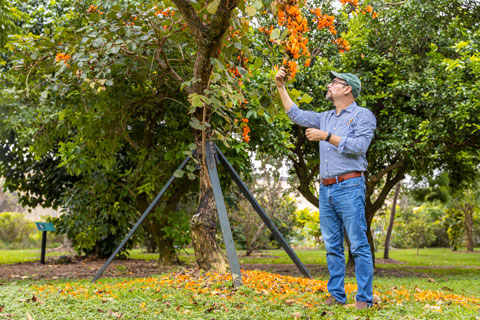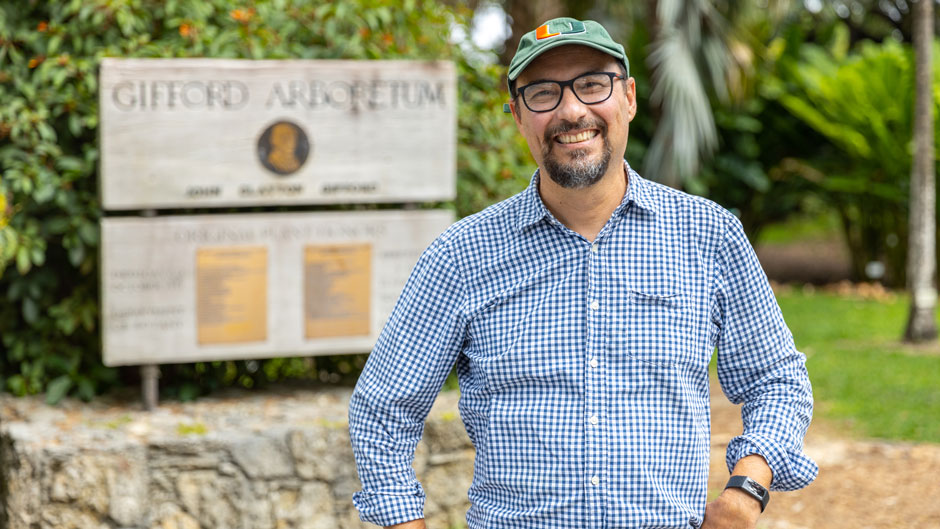He has spent much of his career studying the animals that eat the fruit of tropical trees and help the rainforests multiply. Now, Mauro Galetti is using his knowledge gleaned through years of experience in Brazil’s rainforests to help the University of Miami's tropical tree oasis continue to thrive.
Galetti, a conservation ecologist and associate professor who joined the College of Arts and Sciences Department of Biology this January, was recently named the new director of the John C. Gifford Arboretum. And in his short time at the University, Galetti, who is also an expert in palm trees, has planned two events and forged relationships with many of the other public gardens in Miami, said Athula Wikramanayake, professor and chair of the biology department.
“Every time we lose forests, it affects human society in many different ways, and Professor Galetti has been very informative in pointing out those connections,” said Wikramanayake. “Because of the potential of the arboretum for being a way to preserve some of these endangered tropical species, I asked Mauro to be the director, and he has embraced the opportunity.”

Galetti said the arboretum, which is home to 439 tropical trees and an abundance of tropical plants, is a critical place for ecologists like himself to bring their students. Ecology is a branch of biology that studies the interactions between living things and their environment, as well as how organisms interact with each other along the food chain, he pointed out.
“Instead of studying organisms in a petri dish, the arboretum is a natural lab for ecologists. So, we have to keep the collection well and alive,” said Galetti, who recently took his ecology class to the arboretum to observe lizards. “But it’s also a place for University faculty, staff, and students to relax or to learn about tropical plants.”
Galetti’s research examines the links between animals, the rainforest, and climate change. He moved to the University of Miami from Sao Paolo State University in his native Brazil. Galetti has also taught at Stanford University and Aarhus University in Denmark, although the bulk of his work focuses on the rainforests in Brazil. The South American nation’s rainforests make up about a third of the world’s supply of this ecosystem.
With the advent of development, Galetti said illegal poaching of wild animals such as toucans, tapirs, peccaries (wild boars), and primates, has a direct effect on forest regeneration and ultimately on the climate.
“The animals that eat fruits are the ones that plant the rainforests,’’ he said. Galetti explained that the animals eat the fruit in one place and spread the seeds in another area when they defecate. “And by planting trees, they are helping us to combat climate change because trees store carbon,” he added. “So, there’s an indirect link between the functions of wild animals and climate change.”
While at the University, Galetti hopes to study other important frugivores (animals that eat fruits) such as the black bear and its role in the Everglades ecosystem. But in the immediate future, he is focused on the arboretum.
Galetti is now working with student curator Ezra Remer, as well as Teddy L’Houtellier, the University’s sustainability manager, to replace many of the arboretum’s trees that were lost or damaged in Hurricane Irma. He is also working to attract more students and faculty members to the arboretum. In a recent meeting, the group, along with Terri Hood, ecosystem science and policy senior lecturer, discussed creating a virtual guide to the edible fruit trees in the arboretum. They also shared ideas for putting in pathways and benches throughout the arboretum.
“We want to improve the accessibility in the arboretum, so that more people will use and enjoy it,” Galetti said. “We want to make sure people know about the arboretum, and when you talk to people, not a lot of them do. But it is a beautiful place,” added L’Houtellier.
In his short time as director, Galetti has also organized two events hosted by the arboretum this month. First, the 31st annual Gifford Arboretum lecture will be held on March 19, featuring Pedro Jordano, professor and chair of the environmental sciences and technologies program at the National Research Agency in Spain. Jordano, who has also collaborated with Galetti, is an expert in plant-animal interactions, an author of four books, and has published nearly 200 studies on the topic. Galetti will also host the first academic symposium for the arboretum, uniting ecologists from across the globe for “Mother Nature III: Past, present and the future of species interactions” on March 21 in the Cox Science Center. Both events are open to the University community and the public.
Finally, April 21 is the annual Arbor Day celebration, which typically includes live music in the arboretum, said L’Houtellier, and Galetti noted that the event will include a planting of some new trees.
Started in 1947, Gifford Arboretum was planted by two professors of botany at the University, and it was later named for Gifford, the first graduate forester in the country and a professor of tropical forestry at the University of Miami.
The arboretum is located behind the Cox Science Center on the northwest edge of the Coral Gables campus.

